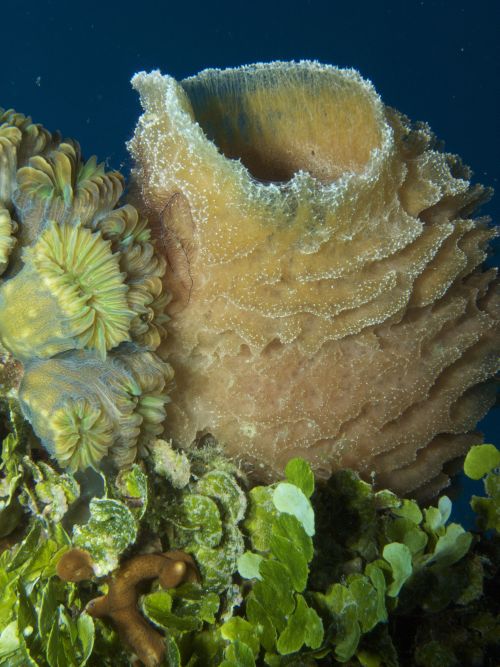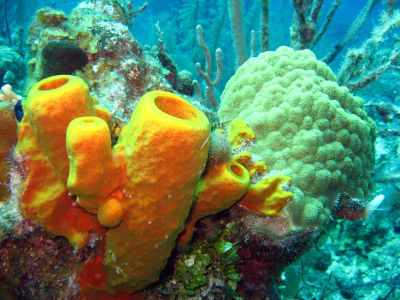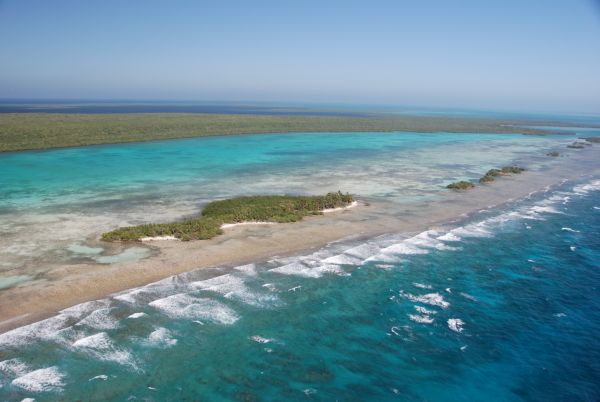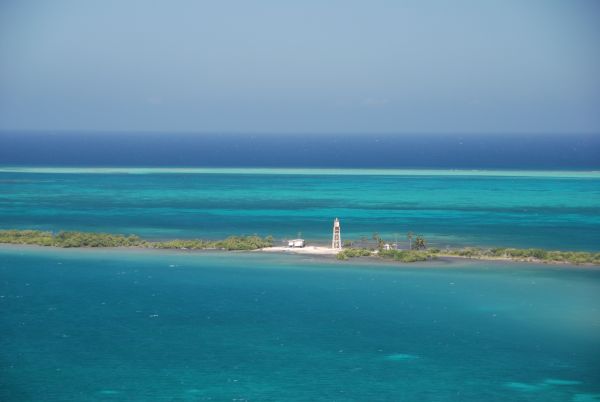Coral reefs are the rainforests of the tropical seas filled with vibrant life in a multitude of shapes, sizes and colors. The beauty and complexity of this ecosystem draws tourists to Belize which is important to Belize's national economy. The reef supports fishermen that use Turneffe as an important fishing area.
Turneffe is considered one of the best developed coral atolls in the Caribbean. It is surrounded by a fringe reef that is well-developed on the east side, with a well-formed fore reef, reef crest and prominent back reef flats. The large, sheltered, relatively shallow inner lagoon supports patch reefs, cayes and extensive mangrove, while beyond the reef crest, the outer slopes of the Atoll fall steeply away into deep water.
Both hard and soft corals are well represented with at least forty-eight of the sixty species of hard corals known to be in Belize identified at Turneffe. Ten of these are considered critically endangered, endangered or vulnerable on the global scale including the reef building staghorn (Acropora cervicornis) and elkhorn (Acropora palmata) corals. The most abundant species encountered are Sea Ginger (Millepora alcicornis), followed by the Yellow Porites (Porites astreoides), Lettuce Coral (Agaricia tenuifolia) and the endangered Boulder Starr Coral (Montastrea annularis).
Even though the reef at Turneffe, where land based impacts are minimal and water clarity is high, is one of the healthier reefs in the Caribbean, the percentage of live coral at Turneffe has declined significantly over the last twenty years. This is a world-wide trend that has been attributed to a multitude of reasons including climate change, over fishing, pollution and siltation from dredging. Since 1998, when Belize experienced a major coral bleaching episode, bleaching events have been recorded at Turneffe Atoll with increasing frequency, likely accentuated by increased acidification resulting from higher CO2 levels in the seas.




 The seagrass beds of Turneffe are critical for the maintenance of ecosystem connectivity providing the link between the reef and the mangroves. These seagrass meadows stretch from the reef crest across the back reef and through the Central and Northern Lagoons, providing stabilization to the sediments of the sea bed and helping to maintain some of the most productive lobster grounds in Belize. While composed primarily of Turtle Grass (Thalassia testudinum), the finer Manatee Grass (Halodule wrightii) and Shoal Grass (Syringodium filiforme) are also common. These seagrass beds support a resident population of west Indian manatees.
The seagrass beds of Turneffe are critical for the maintenance of ecosystem connectivity providing the link between the reef and the mangroves. These seagrass meadows stretch from the reef crest across the back reef and through the Central and Northern Lagoons, providing stabilization to the sediments of the sea bed and helping to maintain some of the most productive lobster grounds in Belize. While composed primarily of Turtle Grass (Thalassia testudinum), the finer Manatee Grass (Halodule wrightii) and Shoal Grass (Syringodium filiforme) are also common. These seagrass beds support a resident population of west Indian manatees. Turneffe Atoll sits on a ridge surrounded on all sides by a deep water with depths of up to 900 feet on the West side between Turneffe and the barrier reef, and 3300 feet on the East side between the Turneffe and Lighthouse Atoll. The deep waters along the eastern side of the atoll provide the currents and conditions required for spawning aggregations. Here fish such as snapper and grouper gather in the thousands during the full moon. These sites also attract other species known to travel up and down in the deep waters parallel to the reef, including whale sharks, pilot and humpbacked whales and orcas.
Turneffe Atoll sits on a ridge surrounded on all sides by a deep water with depths of up to 900 feet on the West side between Turneffe and the barrier reef, and 3300 feet on the East side between the Turneffe and Lighthouse Atoll. The deep waters along the eastern side of the atoll provide the currents and conditions required for spawning aggregations. Here fish such as snapper and grouper gather in the thousands during the full moon. These sites also attract other species known to travel up and down in the deep waters parallel to the reef, including whale sharks, pilot and humpbacked whales and orcas. Mangroves provide key habitat requirements including shelter, food and nursery areas for a variety of marine species including the commercially important spiny lobster. Extensive mangrove stands cover 62% of the Central Lagoon at Turneffe. The almost unique topography of the Atoll has enabled the deep peaty soils to develop in shallow basins between the sea and the mixed mangrove scrub on its leeward side providing ideal conditions for mangroves to thrive.
Mangroves provide key habitat requirements including shelter, food and nursery areas for a variety of marine species including the commercially important spiny lobster. Extensive mangrove stands cover 62% of the Central Lagoon at Turneffe. The almost unique topography of the Atoll has enabled the deep peaty soils to develop in shallow basins between the sea and the mixed mangrove scrub on its leeward side providing ideal conditions for mangroves to thrive.